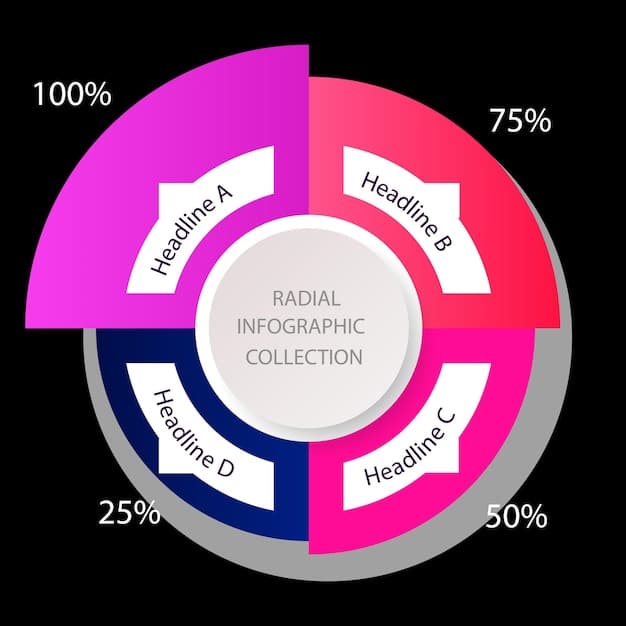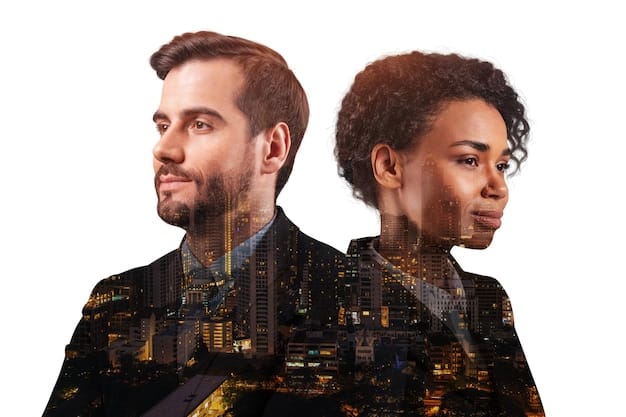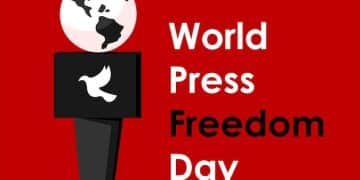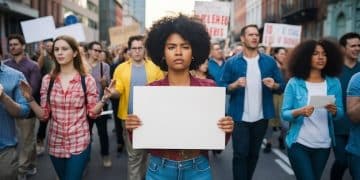Social Media Censorship: How a 15% Rise Could Affect Free Speech in 2025

A projected 15% increase in social media censorship by 2025 raises significant concerns about the future of free speech, potentially leading to reduced expression for marginalized groups, increased polarization, and the stifling of open dialogue on critical issues.
As we approach 2025, discussions surrounding digital rights and content moderation intensify. The potential ramifications of a projected 15% increase in social media censorship are sparking debates across various sectors. How Will the Projected 15% Increase in Social Media Censorship Impact Free Speech in 2025? This question not only invites scrutiny but also compels us to understand the balance between platform governance and individual expression.
Understanding Social Media Censorship in 2025
Social media censorship, the practice of moderating or suppressing user-generated content on digital platforms, is becoming an increasingly relevant topic. Understanding the future landscape involves examining the reasons and methods behind this activity, as well as its potential effects on users and society.
The Rationale Behind Censorship
Platforms implement censorship for various reasons, but the most common are to combat hate speech, misinformation, and other harmful content. As platforms strive to create safer environments, however, they face the challenge of balancing content moderation with free speech principles.
Current Methods of Censorship
Censorship takes many forms on social media, from automated content removal to manual moderation by human reviewers. These methods are designed to enforce platform policies but can sometimes lead to legitimate content being flagged or deleted.
- Automated Content Removal: Algorithms detect and remove content based on pre-defined criteria.
- Manual Moderation: Human moderators review content and enforce platform guidelines.
- Shadow Banning: Reducing a user’s visibility without explicitly banning them.
In conclusion, social media censorship is driven by the need to create safer online environments, but it also raises complex questions about freedom of expression. As we consider the impact of increased censorship by 2025, understanding these mechanisms is crucial.
The Projected 15% Increase: What Does It Mean?
A projected 15% increase in social media censorship signifies an escalation of current content moderation practices. This increase means platforms are expected to become more aggressive in their efforts to regulate online content.
Factors Driving the Increase
Several factors may contribute to the projected increase. Growing regulatory pressures, public demand for safer online environments, and advancements in AI-driven content moderation are key drivers.
Potential Scenarios for 2025
With more stringent censorship measures, social media users may experience more frequent content removals, account suspensions, and restrictions on certain types of speech. This could lead to a reduction in diverse viewpoints and open expression.

- Increased Content Removals: More posts, comments, and videos are flagged and removed.
- Account Suspensions: Users face temporary or permanent bans for violating platform policies.
- Restricted Speech: Certain topics or viewpoints may be suppressed or discouraged.
In summary, a 15% surge in censorship represents a significant shift in how social media platforms manage content. This change has considerable implications for the exercise of free speech online and the diversity of voices heard.
Impact on Free Speech: A Closer Look
The most concerning aspect of increased social media censorship is its impact on free speech. The balance between protecting users and upholding the principles of free expression is delicate but crucial.
The Core of Free Speech
Free speech, as enshrined in the First Amendment of the U.S. Constitution, guarantees individuals the right to express their opinions without government interference. However, the application of this principle on private platforms is debated.
How Censorship Narrows the Boundaries of Speech
Increased censorship can lead to the suppression of legitimate viewpoints, especially if content moderation is biased or overly aggressive. This narrowing of acceptable speech can have serious consequences for public discourse.

- Suppression of Legitimate Viewpoints: Opinions that do not violate laws are removed.
- Bias in Content Moderation: Certain viewpoints are disproportionately targeted for removal.
- Chilling Effect: Users self-censor to avoid penalties.
In conclusion, the extent to which censorship impacts free speech depends on how it is implemented and the degree to which it limits legitimate expression. The consequences can range from minimal inconvenience to significant restrictions on public dialogue.
Concerns for Marginalized Groups
Marginalized groups may disproportionately experience the negative effects of increased social media censorship. Content moderation can sometimes silence voices that already struggle to be heard.
Challenges Faced by Marginalized Voices
These groups often rely on social media to share their experiences, organize advocacy efforts, and build supportive communities. Censorship can disrupt these vital communication channels.
Biases in Content Moderation
Algorithmic and human biases can result in the disproportionate removal of content created by or about marginalized groups. This can further exacerbate existing inequalities and suppress important perspectives.
In summary, more stringent censorship measures may adversely affect marginalized groups, limiting their ability to communicate, organize, and advocate for their rights on social media. The result is a significant reduction in diversity of thought.
The Role of Social Media Platforms
Social media platforms play a complex role in the debate over censorship. They are private entities with the power to set their own rules, but they also function as important public forums.
Setting Community Standards
Platforms create community standards to define acceptable behavior and content. These standards often reflect a desire to protect users from harm, but they can also be used to justify censorship.
Balancing Act: Freedom vs. Safety
Platforms must balance the need to provide a safe and inclusive environment with the imperative to protect free expression. This tension often leads to difficult decisions about content moderation.
- Defining Acceptable Behavior: Platforms set clear guidelines for user conduct.
- Enforcing Policies: Platforms implement measures to address violations of their standards.
- Ethical Considerations: Platforms must consider the ethical implications of their actions on society.
In conclusion, social media platforms are pivotal players in shaping the future of free speech online. They face the challenge of creating rules that promote both safety and open expression, a task that requires careful consideration.
Navigating the Future: Strategies for Free Speech
Looking ahead, several strategies can help ensure that free speech rights are protected in the face of increased social media censorship.
Transparency and Accountability
Platforms should be transparent about their content moderation practices, providing clear explanations for content removals and account suspensions. Accountability mechanisms can help ensure fairness and consistency in enforcement.
Decentralized Platforms
Decentralized social media platforms offer an alternative to traditional centralized networks. By distributing content and power across multiple nodes, these platforms can reduce the risk of censorship.
In summary, preserving free speech in the age of social media censorship requires a multi-pronged approach. Promoting transparency, supporting decentralized platforms, and empowering users can help maintain a vibrant and open online environment.
| Key Point | Brief Description |
|---|---|
| ⚠️ Censorship Increase | A 15% rise in censorship measures on social platforms is anticipated by 2025. |
| 🗣️ Free Speech Concerns | Increased censorship may limit the scope of acceptable viewpoints and free expression online. |
| 📢 Marginalized Groups | Marginalized groups may be disproportionately affected by content moderation biases. |
| 🌐 Platform Responsibility | Platforms struggle to strike a balance between ensuring user safety and protecting freedom of expression. |
FAQ
Social media censorship includes monitoring and regulating content posted by users on digital platforms, often to remove hate speech, misinformation, or violations of community standards. Different approaches include automated flagging and human review.
The expected increase is driven by factors like growing legal pressures on social media companies, higher public demand for safer online spaces, and advancements in technologies that allow better content filtering.
Users could experience more frequent content removals or account suspensions, and may feel compelled to self-censor to avoid penalties, diminishing diversity and potentially silencing marginalized viewpoints.
Yes, decentralized social media platforms offer alternatives. They distribute content among numerous nodes, reducing single points of control and potentially lessening censorship risks.
Users can support transparency, advocate for decentralized platforms, and educate themselves on digital rights. This includes demanding clear explanations for censorship and promoting ethical considerations.
Conclusion
In conclusion, the prospect of a 15% increase in social media censorship by 2025 raises critical questions about the future of free speech. The balance between ensuring user safety and preserving open dialogue is vital, requiring vigilance, advocacy, and the embrace of alternative platforms to safeguard our digital rights.





